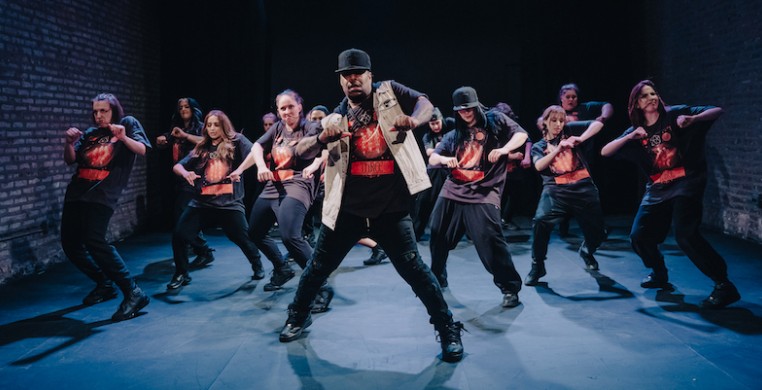On Dec 4, Boom Crack! Dance Company (BCDC) celebrated their fundraising gala at the Den Theatre with two hour-long performances that showcased the company’s variety of artistic talents, including hip hop technical execution, consistent theme development and community building between audience and performers. “Three” was a collaborative creation between artistic director Trae Turner and the company members that engaged the sold-out audience in nuanced movement and full-bodied expression of an R&B and hip hop score that explored the connection between mind, body and soul.
The 15-member company usually performs short pieces ranging a couple minutes at competitions and community showcases. “Three” acted as an opportunity for Boom Crack! to channel another side of their artistry by building these smaller works into a larger story. I attended the 8:00 p.m. performance, which featured slightly different programming from the 5:00 p.m. performance. The works were choreographed by Turner, Krista Ellensohn, Alexa Krutchen, Sophia Santore, Susan Skrzymowski—with input from the other dancers. Bang Bang! Dance Company, BCDC’s intermediate adult company also performed one piece in a stellar display of skill practically indistinguishable from that of the professional company.
The evening began with three, one-minute preludes that illustrated the various elements that influenced the company’s creative process. “Prelude I” focused on individual freestyle that inspired much of BCDC’s choreography. Ensemble choreography was the focus of “Prelude II” with the dancers performing much of the movement in unison. “Prelude III” brought in more footwork and softer, fluid movements that appeared to draw inspiration from contemporary or jazz port de bras. “Three” was a culmination of these three preludes, combining freestyle, detailed and sharp isolations, footwork and contemporary-modern elements to connect the seven shorter choreographed pieces into a cohesive concert.
The power of the company’s performance was the ability of the dancers and choreographers to shift between quick isolations, to smooth rolls through the body, to heavy and hard-hitting footwork and twerking, to fun interactions with the audience. “Three” began with a dark, empty stage as a calm voice asked, “Who are you? What label are you grasping for?” This introspective thinking would come back multiple times throughout the performance to set the framework for the dancers as they explored darker themes of self-doubt and depression, as well as brighter commentary on reclaiming oneself and celebrating your identity.
I’m used to seeing hip hop crews similar to BCDC—both in ensemble size and a movement influenced from more commercial and competitive hip hop dancing—rely on over-the-top choreography where the energy is always high and the movement fast-paced. The beauty of BCDC’s choreography and performance was the consistent use of subtlety throughout the evening. Dancers and choreographers followed large, heavy moments with soft, small moments. The unexpectedness of this subtlety provided just as much excitement as the rest of the choreography, with the audience cheering wildly for an isolated shoulder roll, a sway with arms tucked into the body or stillness on stage as one dancer smirked at the audience.
One of the most-captivating moments of the evening was “Wine,” choreographed by Santore and Turner. Much of the work was a somber solo performed by Santore under a small beam of light from the ceiling (Lauren Rose Girard Forster designed both the lighting and sound for the evening). I found myself holding my breath as I watched Santore rage with small, quick arm movements, wide footwork and emotion that waved through her body. These few minutes with just Santore onstage provided welcome juxtaposition to the rest of “Three” which drew from the energy created by having multiple bodies onstage. The magic of Santore’s solo was unique to this experience of witnessing hip hop in a black-box theater setting. With stage elements pared down, I could be up close with the dancers and hyper-focused on the movement itself.
The performance ended with a work highlighting the “soul” portion of mind, body and soul: a hype finale with the entire Boom Crack! Dance Company ensemble. Turner’s and Skrzymowski’s choreography titled, “Organized Chaos,” fittingly celebrated the company’s passion for hip hop with complex use of levels and shifting formations to upbeat music that drove high-energy movement. The audience was left with a swell of excitement and adrenaline that trickled into the large number of people who lingered after the performance, discussing the show and celebrating with their friends and family in the company.
I appreciated that BCDC adapted their work to a theater space, as I think it opened up their audience to new spectators, including myself. It was a treat to experience something that was at once physical, emotional and fun. I hope to see more extended performances like this by Boom Crack! Dance Company in the future.
--
Editor's note: This is Jordan Kunkel's final review for See Chicago Dance. Jordan has contributed in innumeral ways to writing and programming initiatives at See Chicago Dance as a writer, editor, videographer and digital media specialist. They're a unicorn who does it all; we wish them all the best in her furture endeavors!



